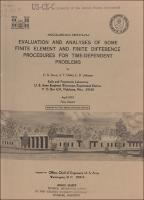Please use this identifier to cite or link to this item:
https://hdl.handle.net/11681/20938Full metadata record
| DC Field | Value | Language |
|---|---|---|
| dc.contributor.author | Desai, C. S. (Chandrakant S.), 1936- | - |
| dc.contributor.author | Oden, J. Tinsley (John Tinsley), 1936- | - |
| dc.contributor.author | Johnson, Lawrence D. | - |
| dc.date.accessioned | 2017-01-17T21:35:48Z | - |
| dc.date.available | 2017-01-17T21:35:48Z | - |
| dc.date.issued | 1975-04 | - |
| dc.identifier.uri | http://hdl.handle.net/11681/20938 | - |
| dc.description | Miscellaneous Paper | - |
| dc.description | Abstract: A large number of schemes using the finite element (FE) and finite difference (FD) methods have been proposed. Numerical and physical properties of these schemes, vital for their use as general procedures and significant from the vievipoint of the user, are often not examined adequately. One of the aims of this study was to examine numerical properties of a selected number of schemes for problems relevant to geotechnical engineering. In this initial phase, the aim has been partially fulfilled by studying the problem of one-dimensional consolidation and wave propagation. Another aim of the research was to examine the concept of space-time finite elements for some time-dependent problems. A portion of Section I involves quantitative analyses of such factors as convergence, stability, and computational efforts for a number of FD and FE schemes for the consolidation problem governed by a linear parabolic equation. Also examined are the effects of the order of the approximation models and behavior of the solution at different locations in space and in time. Mathematical stability criteria are also derived for two time integration schemes with two approximation models for the linear parabolic equation. In Section II, Prof. J. T. Oden has presented mathematical derivations for error estimates of FE approximations to the diffusion equation. The numerical characteristics have been examined and error estimates have been obtained by using semigroup theoretic, energy, and L₂ methods. The work presented in this section is rather fundamental in nature and can provide basis for needed investigations towards numerical analysis of FE procedures. Part V of Section I contains formulations of the concept of space-time finite elements for dynamical systems, and for two equations of fluid flow through porous media. A simple example of the single-degree-of-freedom system is solved quantitatively. Since the project had to be postponed, no quantitative analyses and definitive conclusions were derived for the concept of space-time elements. The topic of evaluation of different numerical schemes is of vital importance. This is particularly so because a large number of schemes have often been proposed without adequate guidelines for the user to assist him in selecting the optimum scheme for his specific needs. It is felt that the work initiated in this study should be continued and schemes for multidimensional problems of practical importance be analyzed and evaluated. | - |
| dc.publisher | Soils and Pavements Laboratory (U.S.) | - |
| dc.publisher | Engineer Research and Development Center (U.S.) | - |
| dc.relation | http://acwc.sdp.sirsi.net/client/en_US/search/asset/1045988 | - |
| dc.rights | Approved for public release; distribution is unlimited. | - |
| dc.source | This Digital Resource was created from scans of the Print Resource | - |
| dc.subject | Finite element method | - |
| dc.subject | Finite difference method | - |
| dc.subject | Mathematical models | - |
| dc.subject | Numerical models | - |
| dc.subject | Time dependence | - |
| dc.subject | Soil mechanics | - |
| dc.subject | Geotechnical engineering | - |
| dc.title | Evaluation and analyses of some finite element and finite difference procedures for time-dependent problems | - |
| dc.type | Report | en_US |
| Appears in Collections: | Miscellaneous Paper | |
Files in This Item:
| File | Description | Size | Format | |
|---|---|---|---|---|
| MP-S-75-7.pdf | 7.16 MB | Adobe PDF |  View/Open |